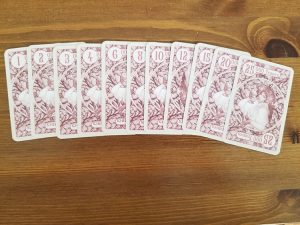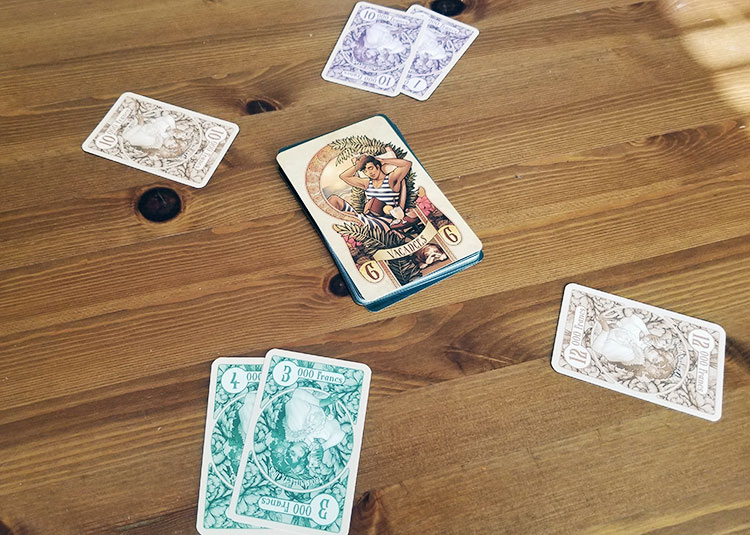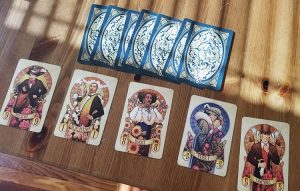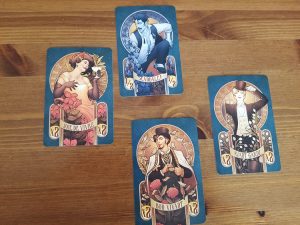 Reiner Knizia is known as one of the greatest board game designers in modern gaming. Ask any fan of his and they’ll say that he’s particularly known for his auction games. Some appear grandiose, with components spread across a mainboard. However, the particular game I’ll be looking at is just a deck of cards.
Reiner Knizia is known as one of the greatest board game designers in modern gaming. Ask any fan of his and they’ll say that he’s particularly known for his auction games. Some appear grandiose, with components spread across a mainboard. However, the particular game I’ll be looking at is just a deck of cards.
The rulebook for High Society states that the players are “the cultural elite, the quintessential bon vivants, the true icons of the age.” The theme comes through mainly through art and one of the key end game evaluations. High Society is a 3-5 player auction game that plays in about 15-30 minutes.
Gameplay Overview:
The players are given the same set of 11 money cards, while the deck of status cards is shuffled and placed in the middle. The object of High Society is to be the most fashionable when the game ends (most fashionable meaning the person with the highest score). The catch is that to be a part of High Society, one must have possessions AND wealth, so before scores are tallied, the player who spent the most money automatically loses.

Each round, one card is auctioned off. The top card from the status deck is revealed, and the player who won the last card begins bidding. If the status card flipped is a luxury card (a card with a positive value/effect) then it is a fairly traditional auction. The players use the 11 cards that they have to bid. They may play multiple cards at once, but once a card is used, it may not be picked up unless they pass. If a player passes, they may no longer win the card being auctioned and they pick up the cards they used to bid. If one player is left remaining in the auction, they claim the card as their own and flip the top status card to begin the next round.
If a disgrace card (a status card with a negative value/effect) is turned up, then the auction works slightly different. Players are bidding to NOT take the status card. Players bid, like a normal round, but once one person passes, they must add the status card to their belongings and resolve the effect of the card. The other players who paid to avoid the disgrace must then lose the money that they bid.
Four of the 16 status cards have a dark green background, and these cards remain face-up when taken by a player. Once the fourth of these dark green cards are revealed, the game immediately ends without bidding on that fourth card. Players count their unspent money and the person with the least is cast out. Those remaining total their status cards and the person with the most points is the winner.

Game Experience:
High Society is not a new game. Ravensburger initially published the game in 1995. It’s jumped between publishers, including a retheme with Amigo, until Osprey Games republished the game in 2018. It’s gone through many art styles, some goofy and others quite plain. Osprey has brought in Medusa Dollmaker for the game’s art. This is the first time we’ve seen her work in the board gaming sphere, but I hope it will not be the last. One look at her art on the status cards (or a deeper look into her online portfolio) and you see the talent she has for bringing life to faces.

As for the game itself, High Society does a lot with so little. There aren’t tokens to punch or board to lay out when setting up. What gives the game its tension is that the entirety of the game is based upon the flipping of the status cards. Not only is it the length of the game, but it also creates the values for the status cards.
While the “nine” or “ten” being auctioned off is always a card of high value, context is key to the true value. If eight other status cards have been auctioned off, then money is scarce due to lavish spending. If it is the first card turned up, then it is hard to determine how much money is too much money to spend on the very first card of the game. If three of the four green background cards are spread between players, the nine or ten have varying importance to each person. This alone makes each game feel unique, as the players are attempting to value the status cards. It’s a huge plus for the replay value.

Players are also determining how much to spend due to the highest spender automatically losing. Before throwing down the cash, a player looking over their leftover money cards hoping that losing one more would keep them in contention for winning. Overspending just once can eliminate that player when the end game rolls around. It makes for great tension in a small package.
The length is quite quick, usually finishing at about the 20-minute mark. It’s always dependent on how quick the green background cards are revealed, so it can be over after all the status cards are revealed or just four. High Society doesn’t overstay its welcome and is a perfect length for the weight of the decisions.
Final Thoughts:
If there are any complaints that could be said about High Society, the main one might be that the entire game is based around the auctions. Those that aren’t fans of auctions should stay away from High Society because it’s all you’re getting. But if you’re down with auctions, Osprey’s reprint is a winner in my books.
Final Score: 4 Stars – A classic auction game from an exceptional game designer gets a new, and improved look.
 Hits:
Hits:
• Decisions are difficult, even with the short length
• Art is incredible
• Game feels different due to the way cards are revealed
• Highest spender losing adds more tension
Misses:
• Entirely made up of auctions
• Not as grandiose as other auction-based games























